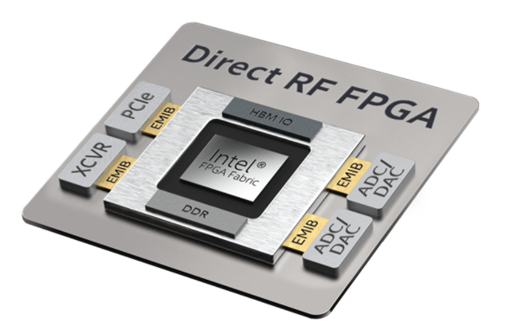Intel recently announced a new technology that enables customers to significantly reduce the size, weight, power and cost of systems used in radar, electronic defense, high-end commercial test equipment and 5G/6G communications markets. Delivering the highest analog converter sample rates in the industry, this transformative technology integrates FPGAs and high-performance analog-to-digital converters (ADC) and digital-to-analog converters (DAC), a revolutionary step toward providing a single component to improve performance, reduce power consumption and shrink the physical size of circuitry.
With this announcement, Intel extends technology scaling from digital semiconductors into the realm of digital plus analog applications. In 5G and 6G applications the bandwidth attained with such high sample rates will directly correlate to high communication bandwidth to enable transporting the massive amount of data the world is now moving wirelessly.
“This breakthrough technology offers more than 5x higher bandwidth than alternative offerings and supports ADC sample rates up to 64 giga samples per second, which open new design possibilities for communications and high-end test and measurement applications, as well as enables radar designers to architect their systems in a completely new way – reducing the number of analog components required and creating more responsive systems,” said Frank Ferrante, director of Military Aerospace and Defense at Intel.

This new FPGA technology, developed in part from research funded by the DARPA CHIPS program, will employ components made in the United States, which is attractive to military and government customers where domestic manufacturing is a priority.
Lockheed Martin was integral in co-defining critical requirements and use cases to enable Intel’s development of the new technology. The partnership between the leading chipmaker and the aerospace giant will result in mission-ready technology.
“This technology allows us to integrate our latest generation electronic warfare systems into smaller airborne platforms and air launched effects that were previously unattainable due to size constraints of the air vehicle. As a result, we’ve created the Ultra Small Affordable Electronic Warfare (USAEW) sensor that provides the 21st century warfighter advanced capabilities while substantially reducing the systems’ size, weight, power and cost by an order of magnitude,” said Deon Viergutz, vice president of Lockheed Martin’s Spectrum Convergence organization.
Moving forward, Intel will continue to collaborate with military, but believes this technology also has the potential to revolutionize analog and digital systems for test and measurement, as well wireless developers.
For information about the USAEW sensor, contact spec-conv.communications@lmco.com.
For more technical detail, please visit: https://www.intel.com/content/www/us/en/architecture-and-technology/programmable/analog-rf-fpga.html




